By C. Todd Lopez
YAKIMA, Wash. (Sept. 26, 2016) -- American and Japanese Soldiers here held a ceremony Friday to close out the three-week-long bilateral "Rising Thunder" exercise, which was held to enhance interoperability between the two nations' armies and to increase their readiness. Rising Thunder kicked off Sept. 6.
About 900 Soldiers overall participated: 300 from Japan's 12th Infantry Regiment, 8th Division, Western Army, out of Kirishima, Japan; and about 600 Soldiers from 2nd Battalion, 1st Infantry Regiment, 2nd Stryker Brigade Combat Team, along with other Soldiers from 2nd SBCT, all part of the 7th Infantry Division out of Joint Base Lewis-McChord, Washington. The exercise took place at the larger than 500-square-mile Yakima Training Center.
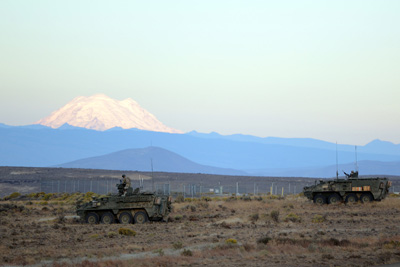
Maj. Gen. Thomas James, 7th Infantry Division commander, said he's participated in the Rising Thunder exercise twice already since he took command of the division in August of 2015. He said the exercise builds trust, familiarity, and interoperability with Japan, an important ally in the Pacific. It also gives the Japanese an opportunity to do something they can't do at home.
"It's critically important because of the relationship we build -- the bilateral relationship with the Japanese -- but also to leverage this great training facility," James said. "They don't have this opportunity in Japan to be able to really get out here in this battlespace and really train what they need to be able to train. So building that partnership and leveraging this capability is what's so important with Rising Thunder."
Lt. Gen. Takashi Motomatsu, commander of the Japanese Ground Self-Defense Force's 8th Division within the Western Army, said training at Yakima Training Center allowed his Soldiers to use their equipment to the fullest.
At Yakima, he said "we can fire with maximum range. There are so many ranges at Yakima Training Center."
And by working together during Rising Thunder, he said, the alliance between the United States and Japan is strengthened.
"We have the alliance between the U.S. and Japan, to facilitate the security environment in the Asia and Pacific region," he said. "If we conduct the bilateral exercise, it means flexible military deterrence options to cope with any contingency."
While Rising Thunder has happened for more than 20 years now, only recently, James said, did it become part of the Pacific Pathways series of deployment-styled exercises, something his division is already involved in, in multiple places.
"We constantly rotate our battalions through different Pathways," James said. "It's kind of interesting right now. We have one battalion that's doing Orient Shield over in Japan and one battalion over here doing Rising Thunder. And we have one battalion doing Yudh Abhyas, an exercise with the Indian Army. We are constantly engaged in the region in working with other armies."
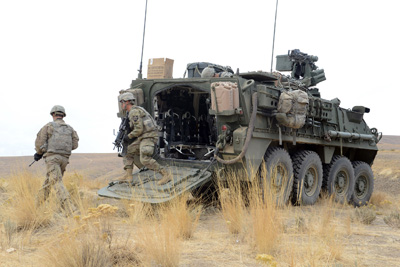
As a part of the Army's Pacific Pathways series of exercises, Rising Thunder is unique in that it doesn't involve an American unit deploying to a foreign location, but rather a partner nation coming to the United States. James said that makes Rising Thunder a "reverse Pathways" exercise.
At the onset of the U.S.-hosted Rising Thunder exercise, Japanese forces participated in "functional training" at the individual, team, squad and platoon level, said Maj. Danny Zimmer, executive officer with 2nd Battalion, 1st Infantry Regiment, part of the 2nd Stryker Brigade Combat Team. He said nearly everything was done bilaterally.
"It was an opportunity for Soldiers and leaders at all levels to practice their skills either with close-quarters marksmanship, sniper training, sniper stalk training, indirect fire training, or maneuver training," Zimmer said.
Beyond functional training, the three-week "decisive action" exercise, Zimmer said, was capped off with a more comprehensive platoon and company-level maneuver event, where Japanese and American Soldiers conducted an attack on an enemy force.
On Sept. 19, both Japanese and American snipers had entered and taken control of a multi-level building to provide sniper support for the taking of a mock village that was down range.
"The first thing that's going to happen is a Japanese helicopter is going to come in and engage the targets on the open ground, from the air," said 1st Lt. John Temme, a scout platoon leader with 2-1 Infantry. "He'll fly right in front of us, kind of hover here for a minute, fire a few rounds, and then fly off. At that point, the snipers will open up on targets of opportunity in the village."
In the facility with Temme was his own sniper section, about 19 Soldiers, and a Japanese sniper section was positioned on the roof as well.
"The helicopters won't fire into the village. They'll fire into the open ground. And once the helicopter is gone and cleared, we'll start shooting into the village and taking out the targets you see in the doorways and in between the buildings. As that's happening, our Charlie company element will move up and will establish a support-by-fire right on the other side of the road. And following them will be the Japanese tanks, and they will set up their support-by-fire right here next to the building."
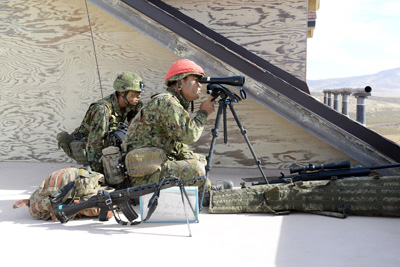
Their goal was to clear the village. And both Japanese and American forces would participate in making that happen, Temme said.
It was his first time working with the Japanese, he said.
"They are really good," he said. "Their equipment is a little bit older than the U.S. equipment. They don't use computers like we use, they just use their brains and a piece of paper."
For his own team, he said, what he hopes they are able to learn is "mostly how to work with and how to learn from and also teach another country's snipers. We do a lot of training setting up sniper schools in other countries. And so we learn how to interact with them, how they are different, and their differences actually help us in a lot of ways too. We learn from each other."
Outside the urban training facility where snipers would provide support for the taking of a village further down range, Sgt. Ryan Casner, a squad leader with Charlie Company's 1st Platoon, 2-1 Infantry, and his Soldiers were loaded up inside two Stryker combat vehicles. They evacuated the vehicles, and each Soldier took his place on the ground outside, with his weapon pointed down range. Then they loaded up and did it again. They did it again and again.
He and his squad were preparing for operations later that night and the next day, part of a company-level maneuvering exercise at another location on Yakima.
"Our mission is coming up later this evening. And pretty much we're working with the Japanese on the mission. We'll be online and maneuvering through terrain to get to a certain objective, and then at which time both the Japanese and U.S. forces will engage the targets," Casner said. He's been in the Army for almost four years now.
Casner and his Soldiers were drilling on how to safely and effectively exit the Stryker.
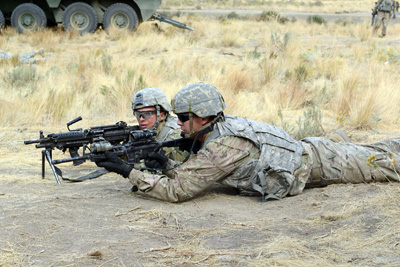
"It's a baseline for our entire squad to conduct just the little things: getting out of the Strykers, getting back on the Strykers, emplacing into a security position. This job isn't about the big picture all the time. It's the little things that'll be the determining factor on how successful you are with your mission," Casner said.
Getting in and out of the Stryker might seem to the untrained to be a simple exercise. And it actually might be in regular circumstances. But combat, or even combat training, is not a regular circumstance, Casner said.
"As simple as it sounds, when you throw adrenaline in there, you throw in live ammunition, and you throw in a guy shooting live rounds, a lot can go wrong," Casner said. "Getting in and out of the Stryker, and making sure your team leaders have control of their guys as they are getting out, comes down to muscle memory. It's about keeping guys from falling down and tripping over themselves, just deliberate movements. You get to the point where you have that muscle memory, and it flows much, much better. The mission has a much higher success rate than it does if you just jump out and jump back in."
Spc. Christopher Page, a team leader under Casner, was one of the Soldiers participating in the training. He's deployed to Afghanistan twice, and has been in the Army going on five years now. He explained there's a formula for the right way for infantry Soldiers to exit the Stryker and to then subsequently position themselves on the ground outside the vehicle and get into fighting positions.
"You want to put your team leader to the rear, so he's the first man off the vehicle and he can control the rest of his team," Page said. "You're going to want your most important pieces out with you," he said. Among those, he said, are the Soldiers with the machine gun and the Squad Automatic Weapon: "the most casualty-producing weapon in the Army."
Working with the Japanese, both Page and Casner said, has been good for them and their squad.
"It's pretty great. They are very intelligent. Their standards and standard operating procedures are very tight," Page said. "They know exactly what they want to do. They know exactly how they want to accomplish their mission. It's nice working with someone who is very prepared to accomplish any tasks, this far from their home."
Casner said working with the Japanese has allowed him to see different ways to do things he does all the time with his own squad.
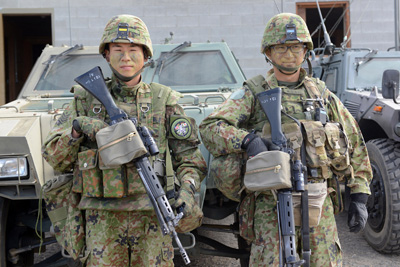
"You learn so much more about how missions can go," Canser said. "You see different vantage points and viewpoints of a different nation. The way we attack an objective is, we have our standards, we have our field manuals. That's what we go by, our doctrine. And then to see the Japanese go through a maneuver, it's a little different. You get a couple different viewpoints of a way a mission can go, and how you can accomplish the mission."
Later that evening, Soldiers moved to the Multi-Purpose Range Complex at the center of Yakima Training Center to prepare for a larger exercise on Tuesday. Many would stay the night on the range.
At nightfall, said Lt. Col. Troy Meissel, commander of the 2nd Battalion, 1st Infantry Regiment, Soldiers from both the Japanese Army and the American Army would prepare for the next days' exercise.
"We have Soldiers at mortar firing points, and at field artillery," Meissel said. "They are in preparation for the next phase of the operation, where we are going to destroy the enemy's recon. That will be conducted tonight. They will be providing illumination rounds: mortars and artillery; 122mm mortar sections for the Japanese and our battalion; and field artillery howitzers."
It's mostly Meissel's Soldiers who are participating in the Rising Thunder exercise. He has Solders from his own battalion, as well as Soldiers with a company from a sister field artillery battalion, with him: about 600 American Soldiers all working alongside the 300 from Japan.
Meissel said for his Soldiers, he hopes they will develop an "appreciation of another country's military, and understanding that language barriers are one thing, but military doctrine is universal."
He also said he hopes the Japanese see the way the American Army makes use of its noncommissioned officer corps. "I'm hoping that they see how our American NCOs are a key part in what makes our military so much better than other militaries in the world."
Meissel also said he knows that the Americans and the Japanese working so closely together at Yakima provides the right strategic message to send to the rest of the world.
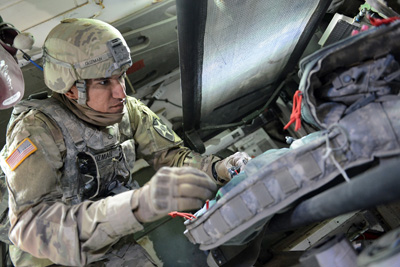
"It allows the rest of the world to understand that the American and Japanese close relationship, militarily, is such that we'll always be there for each other," Meissel said.
On Tuesday at Yakima's Multi-Purpose Range Complex, there were Japanese tanks and American Strykers -- more than a dozen of them -- lined up and ready to move out on an assault that would involve both Japanese and American forces on the ground, and in the air.
The event involved two company-sized elements, about 150 Soldiers each, one from Japan and one from the United States.
Even before the event was over, Col. Jerry Turner, who commands the 2nd Stryker Brigade Combat Team, said he knew the entire Rising Thunder exercise was a success.
"I've decided: it's successful," he said. "If you ask me now, what we are doing out here right now, even if we had a problem arise, that's okay. That's why we are training."
Zimmer said just watching American and Japanese Soldiers interact, even off the training ranges, was a mark of success as well.
"To walk down the street here in the cantonment area, and see U.S. Soldiers talking to Japanese Soldiers outside of the barracks, just shows we've already built relationships," Zimmer said. "And the fact this exercise has run so smoothly so far, shows both units have come together and planned effectively, and synchronized effectively."
While both the Japanese and the Americans have training goals for the exercise, Turner said achieving those training goals together is the real purpose: to achieve interoperability, to ensure that when a real-world contingency comes up, the Americans and the Japanese know how to work alongside each other already.
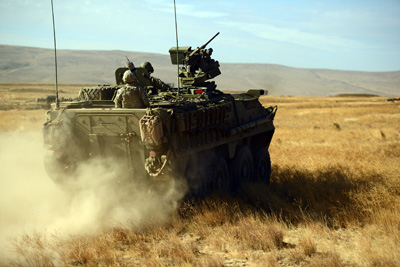
"Interoperability is really the ability to show up in a crisis and be able to conduct operations together. That's harder than it seems," he said. "There are things like language we have to work through, things like culture we have to work through; we have to be able to talk on radios that can talk to each other, we have to be able to share fuel, we have to be able to share food. We have to be able to share all those things, because many times one country may take the lead, and the second country is providing assistance, and you have to be interoperable to pull that off."
Among the kinds of interoperability issues that must be hashed out between the Japanese and Americans, Turner said, is how ammunition is issued, for instance. An agreement had to be worked out.
And Zimmer said that communications technology is always an issue as well -- it's something that always comes up when conducting Pacific Pathways exercises with foreign nations.
"Our networks, our digital systems, FM communications, differ from those countries," Zimmer said. "It's always a friction point. So just conducting these exercises with our partnered nations allows us to get past these friction points easier, and more efficiently, so in case a global crisis does arise, we don't have to spend time figuring it out then."
Zimmer said that the American Army has been impressed, however, with how the Japanese Ground Self-Defense Force sets up their own network.
"And just bottom-line, that's something that every organization, civilian and military, wants to improve. We want to get better. Learning from them how they do that has been good training for us."
Rising Thunder is a combat exercise, "high-end combat," Turner said. But working together with the Japanese, he said, on the most challenging of engagements, means the two nations will be better prepared for contingencies that require less.
"Most militaries will plan for the worst, prepare for the worst," Turner said. "This level of training means we can do anything below. We can certainly do disaster relief, humanitarian assistance is very important for us in the Pacific, based off the things that happen there: the tsunamis, the volcanoes, the fires. So our country works really hard at building those relationships to do those kinds of things, as well as fight."